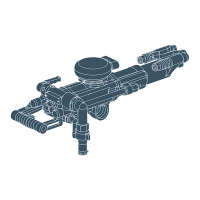13
Problem Cause
Steel parts are a bluish colour The parts have been
subjected to excessive
heat� This can be caused by
insufficient lubrication or
idling
Steel parts have small almost
microscopic fissures on the
wear surfaces
See above
Irregular cavities on the
surface See above of bronze
parts
See above
Cutting marks Secondary damage
Dirt inside the drill
Interior misalignment due to
uneven tension of the side
bolts
Measures to prevent freezing
In low ambient temperatures, ice can form in the machine� This
can be avoided if the water in the compressed air is removed� This
can be done by equipping the air lines with water separators and
drainage points for water condensate�
If the rock drill ices up, it must not be heated to melt the ice� Let
the ice thaw at room temperature�
Note! Do not pour methylated spirits or similar substances into
the rock drill, as they will interfere with the lubrication and lead to
increased wear�
Scrapping and waste disposal
Used and worn-out machines must be disposed of in such a way
that as much of the material as possible can be recycled and the
impact on the environment is kept to a minimum�
Noise and vibration declaration statement
Noise level is meassured according to ISO15744:2002� Vibration
in handle is meassured according to ISO28927-10:2011� See table
"Noise and vibration data" for the value� These declared values
were obtained by laboratory type testing in accordance with the
stated directive or standards and are suitable for comparison with
the declared values of other tools tested in accordance with the
same directive or standards� These declared values are not suit-
able for use in risk assessments and values measured in individu-
al work places may be higher� The actual exposure values and risk
of harm experienced by an individual user are unique and depend
upon the way the user works, in what material the machine is
used, as well as upon the exposure time and the physical condi-
tion of the user, and the condition of the machine� We, Epiroc
Drilling Tools AB, cannot be held liable for the consequences of
using the declared values, instead of values reflecting the actual
exposure, in an individual risk assessment in a work place situa-
tion over which we have no control� This tool may cause hand-arm
vibration syndrome if its use is not adequately managed� An EU
guide to managing hand-arm vibration can be found at http://
www�humanvibration�com/humanvibration/EU/VIBGUIDE�html
We recommend a programme of health surveillance to detect
early symptoms which may relate to vibration exposure, so that
management procedures can be modified to help prevent future
impairment�
Technical data
Parameter/
Model
YT29A YT29AE
YT29AE
(T)
7655D
Product nr 96000010 96000896 96001048 96000004
Product
code
9605-0-
3312300312
9605-0-
3312300340
9605-0-
3312300342
9601-0-
3312300301
Weight
(Kg)
27 27 32 24
Shank size
(mm)
Hex
22 / 25
Hex
22 / 25
Hex
22 / 25
Hex
22
Piston
stroke
(mm)
60 60 60 70
Impact
frequency
(Hz) at 5
bar
≥37 ≥37 ≥37 ≥31
Impact
energy (J)
≥70 ≥70 ≥70 ≥57
Air con-
sumption
(l/s)
≤65 ≤65 ≤65 ≤52
Noise and vibration data
Machine Noise Vibration
YT 29 A 107 dB(A) 7,3 m/s2
YT 29 AE 104 dB(A) 6,6 m/s2
YT29AE(T) 104 dB(A) 6�6m/s2
7655 D 107 dB(A) 5,7 m/s2
Pusher Legs
Parameter\
Model
FT160A FT160B FT160C
Product
Number
96000038 96000039 96000040
Product Code
9616-0-
3312300608
9617-0-
3312300609
9619-0-
3312300610
Weight kg 17 16 18
Length
retracted
mm
1688 1488 1820
Length
extracted mm
3026 2586 3310
Feed length
mm
1338 1098 1490
Piston bore
mm
65 65 65

